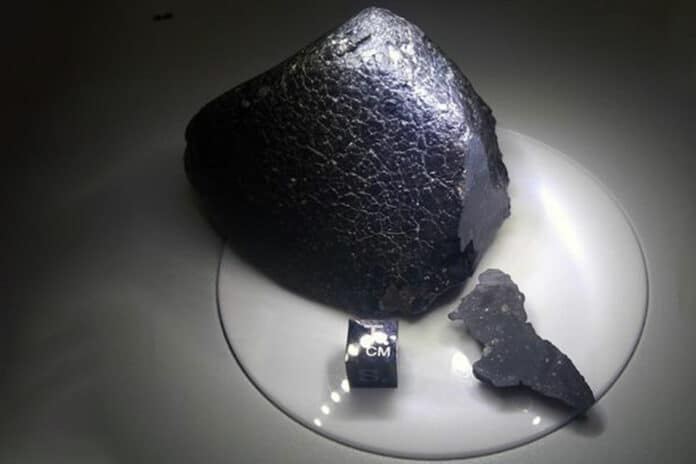Thousands of meteorites enter the Earth’s atmosphere every year. They can land anywhere but are most often spotted in open terrain. The remanent magnetization of meteorites provides invaluable information about how planets formed and evolved. Unfortunately, these ancient magnetic records are commonly destroyed soon after the meteorites are discovered due to a widely used classification technique: touching them with strong magnets.
According to the MIT study, the magnets used to identify meteorites usually erase their magnetic memory, reorienting a rock’s microscopic grains and undoing their original orientation and any trace of its magnetic origins.
Scientists make their case with Northwest Africa (NWA) 7034, a meteorite known in collectors’ circles as “Black Beauty” for its obsidian exterior. NWA 7034 is a polymict regolith breccia containing zircon crystals with crystallization ages over 4.4 billion years.
As such, it contains materials that are sufficiently old to have formed during the time Mars is most likely to have had a core dynamo. Sadly, a team from MIT discovered that several Black Beauty samples had been remagnetized since arriving on Earth, wiping out all traces of an ancient Martian field.
Study author Benjamin Weiss, professor of planetary sciences at MIT, said, “There was an incredible record there and a unique opportunity to understand the early history of Mars’ magnetism. But we found it’s all been obliterated by magnets.”
The team’s latest study outlined how to hand magnets can modify a rock’s inherently magnetic properties. To determine the magnetic field surrounding a normal hand magnet and how it affects rocks of various sizes, they first created a numerical model based on the science of magnetism.
The researchers next conducted experiments, exposing samples of the same terrestrial rock to magnetic fields of differing intensities and distances and measuring the changes in the samples’ innate magnetism. These results demonstrate that the model may be used to assess whether a rock has been remagnetized because the measurements agree with the model’s predictions. The model can also be used to calculate the depth at which a rock might still be unaffected based on its magnetization.
Finally, the team reported their measurements of nine Black Beauty samples and confirmed with their model that every found piece of the meteorite had indeed been exposed to hand magnets.
Weiss said, “What we have in this paper is finally a clear, unambiguous work plan for establishing whether your rock has been hit by a magnet.”
Susceptibility meters, which are portable devices that have been demonstrated to swiftly and reliably identify a meteorite without erasing its magnetic memory, are advised above hand magnets by scientists for meteorite hunters, collectors, and museum curators.
“Susceptibility meters are a hard sell — commercial models are worth several thousand dollars, compared to some hand magnets that cost nothing. Within the meteorite trade, he hopes first to convince people upstream, such as museum curators and collectors. From there, word may trickle down to those making discoveries on the ground.”
“There’s been this incredible explosion of meteorite diversity and number in the last 20 years, and we owe meteorite hunters thanks for finding these things. But the tradeoff, the devil’s bargain, is that often they are using magnets to find them and are immediately destroying their magnetic record in the process.”
Journal Reference:
- Foteini Vervelidou, Benjamin P. Weiss, France Lagroix. Hand Magnets and the Destruction of Ancient Meteorite Magnetism. JGR Planets. DOI: 10.1029/2022JE007464
